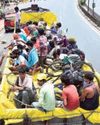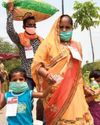
At the time of writing, the total number of COVID-19 cases across the globe had crossed the 1 million mark and the epicentre of the pandemic, four months after it emerged in Wuhan, China, in December 2019, has moved from Europe (Italy) to the United States. The biggest economic power in the world is reeling under the impact of the disease with 3,11,544 confirmed cases and 8,488 deaths (as on April 5) even with stay-at-home advisories and physical distancing measures in place. It is feared that 100,000 to 200,000 could die from the disease in the U.S. In comparison, India’s case load and death toll have been pretty much on the lower side, with 3,374 cases and 77 deaths (as on April 5).
On March 24, following an announcement by Prime Minister Narendra Modi the whole country went into a 21-day lockdown period beginning March 25. This was beyond the various non-pharmaceutical interventions (NPIs)— such as closure of schools and other educational institutions and selected workplaces, restrictive social measures such as physical distancing, stay-at-home/ work-from-home advisories, avoiding mass gatherings, specific hygienic practices and a two-week self-quarantine by people with fever and cough—which were put in place gradually fairly early on since March 5. Obviously, preventing close contact among people through such measures without resorting to lockdown, slows down human-to-human transmission of the virus and as such the rate of increase in the case load would have come down, as was achieved in South Korea, Taiwan, Singapore and Japan. (In the wake of a consistent increase in the number of cases for two weeks, the Singapore Prime Minister announced a month-long partial lockdown, or what he calls “circuit-breaker”, to break transmission chains.)
この記事は FRONTLINE の April 24, 2020 版に掲載されています。
7 日間の Magzter GOLD 無料トライアルを開始して、何千もの厳選されたプレミアム ストーリー、9,000 以上の雑誌や新聞にアクセスしてください。
すでに購読者です ? サインイン
この記事は FRONTLINE の April 24, 2020 版に掲載されています。
7 日間の Magzter GOLD 無料トライアルを開始して、何千もの厳選されたプレミアム ストーリー、9,000 以上の雑誌や新聞にアクセスしてください。
すでに購読者です? サインイン

How Not To Handle An Epidemic
The lockdowns were meant to buy time to put in place appropriate health measures and contain the coronavirus’ spread, but they have failed to achieve the objective and heaped immense misery on the marginalised sections of society. India is still in the exponential phase of the COVID-19 infection and community transmission is a reality that the government refuses to accept.

Tragedy on foot
As the COVID-19-induced lockdown cuts the ground beneath their feet in Tamil Nadu, thousands of migrant workers are trudging along the highway to the relative safety of their upcountry homes.

Sarpanchs as game changers
Odisha manages to keep COVID-19 well under control because of the strong participation of panchayati raj institutions and the community at the grass-roots level under the leadership of Chief Minister Naveen Patnaik.

Scapegoating China
As the COVID-19 death rate spikes and the economy tanks in the United States, Donald Trump and his advisers target China and the World Health Organisation with an eye to winning the forthcoming presidential election.

New worries
Kerala’s measured approach to the pandemic and lockdown has yielded results. But it still has to grapple with their huge economic impact on its economy, which it feels the Centre’s special financial relief package does little to alleviate.
No love lost for labour
Taking advantage of the lockdown and the inability of workers to organise protests, many State governments introduce sweeping changes to labour laws to the detriment of workers on the pretext of reviving production and boosting the economy.

Capital's Malthusian moment
In a world that needs substantial reorienting of production and distribution, Indian capital is resorting to a militant form of moribund neoliberalism to overcome its current crisis. In this pursuit of profit, it is ready and willing to throw into mortal peril millions whom it adjudicates as not worth their means—an admixture of social Darwinism born of capital’s avarice and brutalism spawned by Hindutva. .

Understanding migration
When governments and their plans are found to be blatantly wanting in addressing reverse migration, exercises such as the Ekta Parishad’s survey of migrant workers throughout India can be useful to work out creative long-lasting solutions.

Waiting for Jabalpur moment
The Supreme Court’s role in ensuring executive accountability during the ongoing lockdown leaves much to be desired. Standing in shining contrast is the record of some High Courts.

An empty package
The Modi regime, which has been unable to control the COVID-19 infection, restore economic activity and provide relief to millions exposed to starvation, trains its sights on Indian democracy, making use of the panic generated by fear and a lockdown that forecloses paths of resistance.